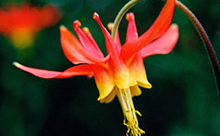What is Natural Gardening?
 Natural gardening creates beautiful, easy to care for lawns and gardens that require little water and are safe for wildlife and waterways. Be a steward with these environmentally friendly options creating habitat for local plant and animals.
Natural gardening creates beautiful, easy to care for lawns and gardens that require little water and are safe for wildlife and waterways. Be a steward with these environmentally friendly options creating habitat for local plant and animals.
Benefits of Natural Gardening
- Save water
- Create and preserve wildlife habitat
- Support local biodiversity, native plants and species at risk
- Stewardship
- Save time and money through reduced maintenance, mowing, pesticides as well as buying and planting annuals
- Reduce the impact of invasive species
Getting Started
Start by taking a look at your current yard. It is helpful to draw a scaled sketch of the yard. Identify what is working for you right now. What is the composition of soil? Is there enough compost and drainage? Determine how much of the lawn is used regularly. Observe how plants are doing in their current location. Are some plants doing poorly or take up a lot of time? With these observations in mind, use the below steps to design your natural garden.
Right Plant, Right Place
How are plants doing? Choose the right plant whose needs fit the actual site conditions found in the garden. A plant with needs specific to the sun and soil conditions in your garden will naturally thrive with less maintenance. Proper plant selection and healthy soils will create healthy gardens that are more resistant to pests and do not require fertilizers.
Before you plant, understand the specific growing conditions:
- Light conditions - full sun, part sun, shade
- Soil type - organic, sandy loam, clay or mineral soil
- Drainage - does water drain quickly or pool?
Group plants with similar water needs to save time and water. Add drought tolerant native plants to reduce watering and maintenance time. This way, you can focus watering on those more thirsty plants when they need it while drought tolerant plants can be left to thrive with rainwater.
Choose native plants for your specific conditions.
Lasagna Gardening
Convert unused areas of lawn to garden with this easy, no dig lasagna gardening technique. Keep rectangular areas of lawn that are easier to mow and maintain. Drought tolerant ornamental grasses and ground covers are great alternatives to lawn that require less water and maintenance.
Garden Designs
Plant species that will grow to your desired height. Create layers starting with trees on the edge of your property and work down with shrubs, ferns, taller plants and ground covers.
Use the Grow Green Guide for custom design ideas.
When creating borders and pathways, use permeable pavers, cobblestones, bricks or natural stone instead of concrete or asphalt to increase the amount of water that infiltrates the ground and feeds your plants. Learn more about permeable paving here.